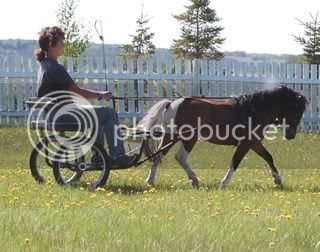Ok here is my two cents. My driving gelding (as well as many many others) has a hard time sitting and driving from his rear. This is not a falt in any way shape or form. A horse is naturally on his forehand with 60% of his weight carried on his two front legs and 40% on his hind. It is our job as riders and drivers to help them shift there weight back. In dressage, which is what driving is mind you, a training level horse is expected to be on his forehand, this is why they are in a lower frame. As you move through the levels the horse begins to shift his weight farther back. In fact it is not until the FEI levels that a horse is expected to be fully driving from his rear...this is done through years and years of training and conditioning and there are very very few horses that can accomplish it. Now back to driving. Your horse is heavy, conformationally on his forehand, which makes the task of shifting his weight back all the more difficult for both him and you. He is overbent in this picture, which is an evasion of his to avoid sitting on his hind end. This is his way of telling you it is hard, and if he is a lazy horse this evasion will be hard (not impossible) to break. I would put him on the lunge in side reins and really ask him to start pushing from the rear by keeping the reins loose and tapping his hocks with the whip to encourage him to swing at his SI joint in his back. He will only be able to do a few steps at first but when he does sit paise the living heck out of him. In the cart again I would keep his reins loose and
forget about headset. He will be nosed out, but that is fine remembering that your are really training a dressage horse and driving him back to front will set his head. By focusing only on getting him on the vertical you will drive backwards or from front to back. He has been in cart enough to start transitions both within the gait and between gaits. My warm-up with my gelding consists of simple transitions from walk to trot as well as halt trot and walk lenghtened trot trans. To get him listening to you and woken up try walking three steps then trot five steps then walk three steps. Repeat this until when you ask for the trot his pushes into it and it is exhurberent and lively. Along with the carrage driving book (which will have alot of what I just said in it) try getting some dressage books and long lining books. Hope this Helps!!!!
Courtney
P.S. Believe me you are fine!!!




